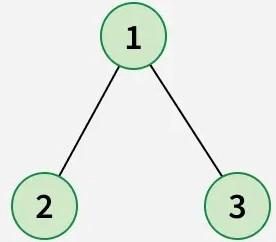Inorder Traversal of Binary Tree (original) (raw)
Last Updated : 28 Mar, 2025
Inorder traversal is a **depth-first traversal method that follows this sequence:
- **Left subtree is visited first.
- **Root node is processed next.
- **Right subtree is visited last.
How does Inorder Traversal work?
**Key Properties:
- If applied to a **Binary Search Tree (BST), it **returns elements in sorted order.
- Ensures that nodes are **processed in a hierarchical sequence, making it useful for expression trees and BSTs.
Examples
**Input:
**Output: 2 1 3
**Explanation: The Inorder Traversal visits the nodes in the following order: Left, Root, Right. Therefore, we visit the left node 2, then the root node 1 and lastly the right node 3.**Input :
Output: 4 2 5 1 3 6
Explanation: Inorder Traversal (Left → Root → Right).** Visit 4 → 2 → 5 → 1 → 3 → 6 , resulting in 4 2 5 1 3 6.
Algorithm :
- If the root is NULL, return.
- Recursively traverse the left subtree.
- Process the root node (e.g., print its value).
- Recursively traverse the right subtree.
C++ `
#include <bits/stdc++.h> using namespace std;
// Structure of a Binary Tree Node struct Node { int data; struct Node *left, *right; Node(int v) { data = v; left = right = nullptr; } };
// Function to print inorder traversal void printInorder(struct Node* node) { if (node == nullptr) return;
// First recur on left subtree
printInorder(node->left);
// Now deal with the node
cout << node->data << " ";
// Then recur on right subtree
printInorder(node->right);}
int main() { struct Node* root = new Node(1); root->left = new Node(2); root->right = new Node(3); root->left->left = new Node(4); root->left->right = new Node(5); root->right->right = new Node(6);
printInorder(root);
return 0;}
C
#include <stdio.h> #include <stdlib.h>
// Structure of a Binary Tree Node struct Node { int data; struct Node *left, *right; };
// Function to print inorder traversal void printInorder(struct Node* node) { if (node == NULL) return;
// First recur on left subtree
printInorder(node->left);
// Now deal with the node
printf("%d ", node->data);
// Then recur on right subtree
printInorder(node->right);}
// Function to create a new node struct Node* newNode(int v) { struct Node* node = (struct Node*)malloc(sizeof(struct Node)); node->data = v; node->left = node->right = NULL; return node; }
int main() { struct Node* root = newNode(1); root->left = newNode(2); root->right = newNode(3); root->left->left = newNode(4); root->left->right = newNode(5); root->right->right = newNode(6);
printInorder(root);
return 0;}
Java
import java.util.*;
// Structure of a Binary Tree Node class Node { int data; Node left, right;
Node(int v)
{
data = v;
left = right = null;
}}
class GfG { // Function to print inorder traversal public static void printInorder(Node node) { if (node == null) return;
// First recur on left subtree
printInorder(node.left);
// Now deal with the node
System.out.print(node.data + " ");
// Then recur on right subtree
printInorder(node.right);
}
public static void main(String[] args)
{
Node root = new Node(1);
root.left = new Node(2);
root.right = new Node(3);
root.left.left = new Node(4);
root.left.right = new Node(5);
root.right.right = new Node(6);
printInorder(root);
}}
Python
class Node: def init(self, v): self.data = v self.left = None self.right = None
Function to print inorder traversal
def printInorder(node): if node is None: return
# First recur on left subtree
printInorder(node.left)
# Now deal with the node
print(node.data, end=' ')
# Then recur on right subtree
printInorder(node.right)if name == 'main': root = Node(1) root.left = Node(2) root.right = Node(3) root.left.left = Node(4) root.left.right = Node(5) root.right.right = Node(6)
printInorder(root)C#
using System;
// Structure of a Binary Tree Node public class Node { public int data; public Node left, right;
public Node(int v)
{
data = v;
left = right = null;
}}
public class BinaryTree { // Function to print inorder traversal public static void printInorder(Node node) { if (node == null) return;
// First recur on left subtree
printInorder(node.left);
// Now deal with the node
Console.Write(node.data + " ");
// Then recur on right subtree
printInorder(node.right);
}
public static void Main()
{
Node root = new Node(1);
root.left = new Node(2);
root.right = new Node(3);
root.left.left = new Node(4);
root.left.right = new Node(5);
root.right.right = new Node(6);
printInorder(root);
}}
JavaScript
// Structure of a Binary Tree Node class Node { constructor(v) { this.data = v; this.left = null; this.right = null; } }
// Function to print inorder traversal function printInorder(node) { if (node === null) { return; }
// First recur on left subtree
printInorder(node.left);
// Now deal with the node
console.log(node.data);
// Then recur on right subtree
printInorder(node.right);}
const root = new Node(1); root.left = new Node(2); root.right = new Node(3); root.left.left = new Node(4); root.left.right = new Node(5); root.right.right = new Node(6);
printInorder(root);
`
**Time Complexity: O(n), n is the total number of nodes
**Auxiliary Space: O(h), h is the height of the tree.
In the worst case, **h can be the same as **N (when the tree is a skewed tree)
In the best case, **h can be the same as **log N (when the tree is a complete tree)
**Related Articles:


